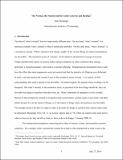| dc.contributor.author | Haslanger, Sally | |
| dc.date.accessioned | 2015-06-05T17:07:06Z | |
| dc.date.available | 2015-06-05T17:07:06Z | |
| dc.date.issued | 2014-09 | |
| dc.identifier.issn | 2240-7901 | |
| dc.identifier.uri | http://hdl.handle.net/1721.1/97196 | |
| dc.description.abstract | The idea of "what's normal" has two importantly different uses. On one hand, "what's normal" is a statistical concept: what's normal is what is statistically probable. On the other hand, "what's normal," is a normative concept. What's normal is how things "ought" to be, or how things are when circumstances are favorable. The normative sense of 'normal,' can be linked to the historical concept of essence. Things manifest their nature or essence under normal conditions; in other conditions they emerge deformed: a normal pregnancy will result in a normal offspring. Moreover, the normatively normal is invoked to back social norms: women ought to stay home with their babies because it is in the nature of things, or in the nature of things when circumstances are favorable. However, what's "normal" is not always natural, and what's natural is not always best. Interestingly, the confusions just sketched are reinforced by the fact that we use generics such as 'cars have radios,' 'birds fly,' or 'boys don't cry,' to state all three sorts of claims: statistical regularities, claims about natures, and claims about norms. Scholars have suggested that the variety in different forms of generics prevents a unified account. In this essay, I offer a proposal for understanding how the many different kinds of generics can be understood as differing in their implicatures due to essentialist assumptions that are included by default in the common ground of conversation. This helps explain how essentialist ideology is expanded and sustained. | en_US |
| dc.language.iso | en_US | |
| dc.publisher | Societa Editrice il Mulino | en_US |
| dc.relation.isversionof | http://dx.doi.org/10.4476/78098 | en_US |
| dc.rights | Creative Commons Attribution-Noncommercial-Share Alike | en_US |
| dc.rights.uri | http://creativecommons.org/licenses/by-nc-sa/4.0/ | en_US |
| dc.source | Haslanger | en_US |
| dc.title | The normal, the natural and the good: Generics and ideology | en_US |
| dc.type | Article | en_US |
| dc.identifier.citation | Haslanger, Sally. “The normal, the natural and the good: Generics and ideology.” Politica & Societa 3 (2014): 365–392. | en_US |
| dc.contributor.department | Massachusetts Institute of Technology. Department of Linguistics and Philosophy | en_US |
| dc.contributor.approver | Haslanger, Sally | en_US |
| dc.contributor.mitauthor | Haslanger, Sally | en_US |
| dc.relation.journal | Politica & Societa | en_US |
| dc.eprint.version | Author's final manuscript | en_US |
| dc.type.uri | http://purl.org/eprint/type/JournalArticle | en_US |
| eprint.status | http://purl.org/eprint/status/PeerReviewed | en_US |
| dspace.orderedauthors | Haslanger, Sally | en_US |
| mit.license | OPEN_ACCESS_POLICY | en_US |
| mit.metadata.status | Complete | |
